Small-Scale Mechanical Testing of Cemented Carbides from the Micro- to the Nano-Level: A Review
Abstract
:1. Introduction
2. Micro/Nanoindentation
3. Micro/Nano-Tribology and Scratch Testing
4. Micropillar Compression
5. Micro-Cantilever Bending and Tensile Test
- (1)
- Bars from single WC grains without a clear fracture origin, with failure at the fixed end of the cantilever;
- (2)
- Bars from single WC grains with evident fracture origin in the form of nano-sized defects, with failure further from the fixed end of the cantilever;
- (3)
- Bars containing a WC/WC boundary as fracture origin with failure at this boundary.
6. Summary and Further Challenges
- The micro/nanoindentation tests revealed that the influence of the composition and microstructure parameters of hardmetals on their hardness at the micro level was very similar to that at the macro level. The nanohardness was largely determined by the hardness of the individual phase of the composite under the indenter. Some special micromechanical tests, e.g., the indentation fatigue test, found unusual deformation behavior of WC–Co systems arising from the deformation and damage characteristics of its individual phases. The hardness and indentation modulus of WC grains show clear orientation dependence, with the basal plane showing a significantly higher hardness (approximately 1.4 times higher) than the prismatic one.
- Thanks to the progression of high-resolution equipment and methods with good stability and ultra-low drift, small-scale tribological experiments offer new opportunities to investigate the interaction between surfaces and have helped to advance our fundamental understanding of friction, lubrication, and wear of hardmetals at the single asperity contact. Investigation of the influence of the crystal orientation of the WC grains in WC–Co cemented carbide on their nanoscratch resistance discovered a significant anisotropy, with significantly stronger scratch resistance of WC grains oriented close to the basal orientation than for WC grains close to the prismatic orientation.
- During micropillar tests, the effect of the scale on the mechanical response of WC–Co composites was clearly connected with the composition and microstructure of the tested micropillars. In the case of micropillars with a number of WC grains and binder areas, the deformation behavior during the compressive test included deformation and damage features at the WC/WC and WC/Co boundaries or in the binder phase. In the case of micropillars prepared from one WC grain (single crystal micropillars), the orientation was found to have a significant influence, with micropillar rupture stress of approximately σr = 7.5 GPa and σr = 12.5 GPa for axes parallel and perpendicular to the basal plane, respectively. The different slip and dislocation mechanisms acting in differently-oriented pillars are probably responsible for this behavior.
- The micro-cantilever and micro-tensile strength of WC–Co hardmetals and their constituents is very sensitive to the fracture origin. The strength of WC grains without the fracture origin is around 20–25 GPa; the strength of WC/WC twist boundaries is similar. The strength of the WC grains with nano-sized defect/fracture origin is below 10 GPa and the strengths of the the WC/Co interphase boundary and the Co ligaments are approximately 3 GPa. More investigation is required into the strength of WC/WC boundaries with different WC grain orientations and the strength of the WC/Co/WC boundaries.
Further Challenges
- Optimization of experimental conditions: (i) Mechanically-polished surface preparation connected with nanoindentation and scratch tests; (ii) damage-free FIB-milled specimen preparation (micropillar, cantilevers, and tensile samples); (iii) misalignment during the micropillar and micro-cantilever test; (iv) different testing rates and modes (fatigue, impact, etc.); (v) tests at high temperatures—indenter tip, etc.; (vi) in situ testing in combination with analytical units.
- Effect of the microstructure parameters on (i) deformation, damage, and fracture phenomenon during micro-indentation and micropillar compression and (ii) deformation and damage evolution during micro/nano-scratching and tribology.
- Size and orientation effect of constituent phases: (i) Indentation size effect during the micro- and nanohardness testing of different carbide and binder phases; (ii) effect of size/diameter of micropillars and crystal orientation during micro-compression on slip activation, deformation mechanisms, yield and rupture strength of carbide phases; (iii) effect of cantilever size and crystal orientation on bending strength, Young‘s modulus, fracture toughness, etc.; (iv) effect of the crystal orientation of neighboring carbide grains on carbide/carbide interphase fracture and fatigue strength during micro-cantilever test.
- Loading rate/mode and temperature effect on deformation and damage characteristics of (i) micro-sized bulk hardmetals, (ii) their constituents, and (iii) their interphases.
- Modeling—by way of density functional theory (DFT) calculation, discrete dislocation dynamics modeling, etc.—of the observed phenomena concerning the deformation, damage, and fracture mechanisms in different hardmetals, in order to assist the design and development of new systems with an optimal combination of mechanical and tribological properties.
Acknowledgments
Conflicts of Interest
References
- Exner, H.E. Physical and chemical nature of cemented carbides. Int. Met. Rev. 1979, 4, 149–173. [Google Scholar]
- Roebuck, B.; Almond, E.A. Deformation and fracture processes and the physical metallurgy of WC–Co hardmetals. Int. Mater. Rev. 1988, 33, 90–110. [Google Scholar] [CrossRef]
- Upadhyaya, G.S. Cemented Tungsten Carbides: Production, Properties and Testing, 1st ed.; Noyes Publications: Park Ridge, NJ, USA, 1998. [Google Scholar]
- Shatov, A.V.; Ponomarev, S.S.; Firstov, S.A. Fracture and strength of hardmetals at room temperature. Compr. Hard Mater. 2014, 301–339. [Google Scholar]
- Luyckx, S.B. Role of inclusions in the fracture initiation process in WC-Co alloys. Acta Metal. 1975, 23, 109–115. [Google Scholar] [CrossRef]
- Jonke, M.; Klünsner, T.; Supancic, P.; Harrer, W.; Glätzle, J.; Barbist, R.; Ebner, R. Strength of WC-Co hard metals as a function of the effectively loaded volume. Int. J. Refract. Met. Hard Mater. 2017, 64, 219–224. [Google Scholar] [CrossRef]
- Lee, H.C.; Gurland, J. Hardness and deformation of cemented tungsten carbide. Mater. Sci. Eng. 1978, 33, 125–133. [Google Scholar] [CrossRef]
- Chermant, J.L.; Osterstock, F. Elastic and plastic characteristics of WC–Co composite materials. Powder Metall. Int. 1979, 11, 106–109. [Google Scholar]
- Klunsner, T.; Marsoner, S.; Ebner, R.; Pippan, R.; Glatzle, J.; Puschel, A. Effect of microstructure on fatigue properties of WC–Co hardmetals. Procedia Eng. 2010, 2, 2001–2010. [Google Scholar] [CrossRef]
- Roebuck, B.; Maderud, C.J.; Morrell, R. Elevated temperature fatigue testing of hardmetals using notched test pieces. Int. J. Refract. Met. Hard Mater. 2008, 26, 19–27. [Google Scholar] [CrossRef]
- Sigl, L.S.; Exner, H.E. Experimental study of the mechanics of fracture in WC–Co alloys. Metall. Trans. A 1987, 18, 1299–1308. [Google Scholar] [CrossRef]
- Fischmeister, H.F.; Schmauder, S.; Sigl, L.S. Finite element modelling of crack propagation in WC-Co hard metals. Mater. Sci. Eng. A 1988, 105–106, 305–311. [Google Scholar] [CrossRef]
- Sigl, L.S.; Fischmeister, H.F. On the fracture toughness of cemented carbides. Acta Metall. 1988, 36, 887–897. [Google Scholar] [CrossRef]
- Chermant, J.L.; Osterstock, F. Fracture toughness and fracture of WC–Co composites. J. Mater. Sci. 1976, 11, 1939–1951. [Google Scholar] [CrossRef]
- Llanes, L.; Torres, Y.; Anglada, M. On the fatigue crack growth behaviour of WC–Co cemented carbides: Kinetics description, microstructural effects and fatigue sensitivity. Acta Mater. 2002, 50, 2381–2393. [Google Scholar] [CrossRef]
- Torres, Y.; Bermejo, R.; Gotor, F.J.; Chicardi, E.; Llanes, L. Analysis on the mechanical strength of WC-Co cemented carbides under uniaxial and biaxial bending. Mater. Des. 2014, 55, 851–856. [Google Scholar] [CrossRef]
- Konyashin, I.; Ries, B.; Hlawatschek, S.; Mazilkin, A. Novel industrial hardmetals for mining, construction and wear applications. Int. J. Refract. Met. Hard Mater. 2018, 71, 357–365. [Google Scholar] [CrossRef]
- Konyashin, I.; Ries, B.; Lachmann, F.; Fry, A.T. A novel sintering technique for fabrication of functionally gradient WC–Co cemented carbides. J. Mater. Sci. 2012, 47, 7072–7084. [Google Scholar] [CrossRef]
- Linder, D.; Holmström, E.; Norgren, S. High entropy alloy binders in gradient sintered hardmetal. Int. J. Refract. Met. Hard Mater. 2018, 71, 217–220. [Google Scholar] [CrossRef]
- Pötschke, J.; Säuberlich, T.; Vornberger, A.; Meese-Marktscheffel, J.A. Solid state sintered nanoscaled hardmetals and their properties. Int. J. Refract. Met. Hard Mater. 2018, 72, 45–50. [Google Scholar] [CrossRef]
- Dehm, G.; Jaya, B.N.; Raghavan, R.; Kirchlechner, C. Overview on micro-and nanomechanical testing: New insights in interface plasticity and fracture at small length scales. Acta Mater. 2018, 142, 248–282. [Google Scholar] [CrossRef]
- Fischer-Cripps, A.J. Nanoindentation, 3rd ed.; Springer: Berlin, Germany, 2011. [Google Scholar]
- Oliver, W.C.; Pharr, G.M. Measurement of hardness and elastic modulus by instrumented indentation: Advances in understanding and refinements to methodology. J. Mater. Res. 2004, 19, 3–20. [Google Scholar] [CrossRef]
- Oliver, W.C.; Pharr, G. An improved technique for determining hardness and elastic modulus using load and displacement sensing indentation experiments. J. Mater. Res. 1992, 7, 1564–1583. [Google Scholar] [CrossRef]
- Broitman, E. Indentation Hardness Measurements at Macro-, Micro-, and Nanoscale: A Critical Overview. Tribol. Lett. 2017, 65. [Google Scholar] [CrossRef]
- Pethica, J.B.; Hutchings, R.; Oliver, W.C. Hardness measurement at penetration depths as small as 20 nm. Philos. Mag. A 1983, 48, 593–606. [Google Scholar] [CrossRef]
- Beake, B.D.; Bell, G.A.; Goodes, S.R.; Pickford, N.J.; Smith, J.F. Improved nanomechanical test techniques for surface engineered materials. Surf. Eng. 2010, 26, 37–49. [Google Scholar] [CrossRef]
- Guillonneau, G.; Mieszala, M.; Wehrs, J.; Schwiedrzik, J.; Grop, S.; Frey, D.; Philippe, L.; Breguet, J.M.; Michler, J.; Wheeler, J.M. Nanomechanical testing at high strain rates: New instrumentation for nanoindentation and microcompression. Mater. Des. 2018, 148, 39–48. [Google Scholar] [CrossRef]
- Uchic, M.D.; Dimiduk, D.M.; Florando, J.N.; Nix, W.D. Sample dimensions influence strength and crystal plasticity. Science 2004, 305, 986–989. [Google Scholar] [CrossRef]
- Korte-Kerzel, S. Microcompression of brittle and anisotropic crystals: Recent advances and current challenges in studying plasticity in hard materials. MRS Commun. 2017, 7, 109–120. [Google Scholar] [CrossRef]
- Kiener, D.; Motz, C.; Dehm, G. Micro-compression testing: A critical discussion of experimental constraints. Mater. Sci. Eng. A 2009, 505, 79–87. [Google Scholar] [CrossRef]
- El-Awady, J.A.; Woodward, C.; Dimiduk, D.M.; Ghoniem, N.M. Effects of focused ion beam induced damage on the plasticity of micropillars. Phys. Rev. B 2009, 80, 104104. [Google Scholar] [CrossRef]
- Kiener, D.; Grosinger, W.; Dehm, G.; Pippan, R. A further step towards an understanding of size-dependent crystal plasticity: In situ tension experiments of miniaturized single-crystal copper samples. Acta Mater. 2008, 56, 580–592. [Google Scholar] [CrossRef]
- Gianola, D.S.; Eberl, C. Micro- and nanoscale tensile testing of materials. JOM 2009, 61, 24–35. [Google Scholar] [CrossRef]
- Dehm, G. Miniaturized single-crystalline fcc metals deformed in tension: New insights in size-dependent plasticity. Prog. Mater. Sci. 2009, 54, 664–688. [Google Scholar] [CrossRef]
- Tsuchiya, T.; Tabata, O.; Sakata, J.; Taga, Y. Specimen size effect on tensile strength of surface-micromachined polycrystalline silicon thin films. J. Microelectromech. Syst. 1998, 7, 106–113. [Google Scholar] [CrossRef]
- Gong, J.; Wilkinson, A.J. A microcantilever investigation of size effect, solid solution strengthening and second-phase strengthening for <a> prism slip in alpha-Ti. Acta Mater. 2011, 59, 5970–5981. [Google Scholar] [CrossRef]
- Motz, C.; Schoberl, T.; Pippan, R. Mechanical properties of micro-sized copper bending beams machined by the focused ion beam technique. Acta Mater. 2005, 53, 4269–4279. [Google Scholar] [CrossRef]
- Kiener, D.; Motz, C.; Grosinger, W.; Weygand, D.; Pippan, R. Cyclic response of copper single crystal micro-beams. Scr. Mater. 2010, 63, 500–503. [Google Scholar] [CrossRef]
- Kiener, D.; Zhang, Z.; Sturm, S.; Cazottes, S.; Imrich, P.J.; Kirchlechner, C.; Dehm, G. Advanced nanomechanics in the TEM: Effects of thermal annealing on FIB prepared Cu samples. Philos. Mag. 2012, 92, 3269–3289. [Google Scholar] [CrossRef]
- Iqbal, F.; Ast, J.; Goken, M.; Durst, K. In situ micro-cantilever tests to study fracture properties of NiAl single crystals. Acta Mater. 2012, 60, 1193–1200. [Google Scholar] [CrossRef]
- Rzepiejewska-Malyska, K.A.; Mook, W.M.; Parlinksa-Wojtan, M.; Hejduk, J.; Michler, J. In situ scanning electron microscopy indentation studies on multilayer nitride films: Methodology and deformation mechanisms. J. Mater. Res. 2009, 24, 1208–1221. [Google Scholar] [CrossRef]
- Kiener, D.; Motz, C.; Dehm, G.; Pippan, R. Overview on established and novel FIB based miniaturized mechanical testing using in-situ SEM. Int. J. Mater. Res. 2009, 100, 1074–1087. [Google Scholar] [CrossRef]
- Legros, M.; Gianola, D.S.; Motz, C. Quantitative in situ mechanical testing in electron microscopes. MRS Bull. 2010, 35, 354–360. [Google Scholar] [CrossRef]
- Wehrs, J.; Deckarm, M.J.; Wheeler, J.M.; Maeder, X.; Birringer, R.; Mischler, S.; Michler, J. Elevated temperature, micro-compression transient plasticity tests on nanocrystalline Palladium-Gold: Probing activation parameters at the lower limit of crystallinity. Acta Mater. 2017, 129, 124–137. [Google Scholar] [CrossRef]
- Korte, S.K.; Clegg, W.J. Micropillar compression of ceramics at elevated temperature. Scr. Mater. 2009, 60, 807–810. [Google Scholar] [CrossRef]
- Wheeler, J.M.; Michler, J. Elevated temperature, nano-mechanical testing in situ in the scanning electron microscope. Rev. Sci. Instrum. 2013, 84, 45–103. [Google Scholar] [CrossRef] [PubMed]
- Jaya, B.N.; Wheeler, J.M.; Wehrs, J.; Best, J.P.; Soler, R.; Michler, J.; Kirchlechner, C.; Dehm, G. Microscale fracture behavior of single crystal silicon beams at elevated temperatures. Nano Lett. 2016, 16, 7597–7603. [Google Scholar] [CrossRef] [PubMed]
- Giannuzzi, L.A.; Stevie, F.A. Introduction to Focused Ion Beams: Instrumentation, Theory, Techniques and Practice, 1st ed.; Springer: Berlin, Germany, 2005. [Google Scholar]
- Banerjee, A.; Banerjee, S.S. Fabrication of single and coupled metallic nanocantilevers and their nanomechanical response at resonance. Nanotechnology 2013, 24, 105306. [Google Scholar] [CrossRef]
- Rajput, N.S.; Banerjee, A.; Verma, H.C. Electron- and ion-beam-induced maneuvering of nanostructures: Phenomenon and applications. Nanotechnology 2011, 22, 485302. [Google Scholar] [CrossRef] [PubMed]
- Korte, S.; Ritter, M.; Jiao, C.; Midgley, P.; Clegg, W. Three-dimensional electron backscattered diffraction analysis of deformation in MgO micropillars. Acta Mater. 2011, 59, 7241–7254. [Google Scholar] [CrossRef]
- Montagne, A.; Pathak, S.; Maeder, X.; Michler, J. Plasticity and fracture of sapphire at room temperature: Load-controlled microcompression of four different orientations. Ceram. Int. 2014, 40, 2083–2090. [Google Scholar] [CrossRef]
- Wheeler, J.; Niederberger, C.; Tessarek, C.; Christiansen, S.; Michler, J. Extraction of plasticity parameters of GaN with high temperature, in situ micro-compression. Int. J. Plast. 2013, 40, 140–151. [Google Scholar] [CrossRef]
- Camposilvan, E.; Anglada, M. Size and plasticity effects in zirconia micropillars compression. Acta Mater. 2016, 103, 882–892. [Google Scholar] [CrossRef]
- Camposilvan, E.; Torrents, O.; Anglada, M. Small-scale mechanical behavior of zirconia. Acta Mater. 2014, 80, 239–249. [Google Scholar] [CrossRef]
- Kiani, S.; Yang, J.M.; Kodambaka, S. Nanomechanics of refractory transition-metal carbides: A path to discovering plasticity in hard ceramics. J. Am. Ceram. Soc. 2015, 98, 2313–2323. [Google Scholar] [CrossRef]
- Kiani, S.; Ratsch, C.; Minor, A.; Yang, J.M.; Kodambaka, S. In situ transmission electron microscopy observations of room-temperature plasticity in sub-micron-size TaC(100) and TaC(011) single crystals. Scr. Mater. 2015, 100, 13–16. [Google Scholar] [CrossRef]
- Csanádi, T.; Németh, D.; Dusza, J.; Lenčéš, Z.; Šajgalík, P. Nanoindentation induced deformation anisotropy in β-Si3N4 ceramic crystals. J. Eur. Ceram. Soc. 2016, 36, 3059–3066. [Google Scholar] [CrossRef]
- Csanádi, T.; Grasso, S.; Kovalčíková, A.; Dusza, J.; Reece, M.J. Nanohardness and elastic anisotropy of ZrB2 crystals. J. Eur. Ceram. Soc. 2016, 36, 239–242. [Google Scholar] [CrossRef]
- Csanádi, T.; Chinh, N.Q.; Szommer, P.; Dusza, J.; Lenčés, Z.; Šajgalík, P. Deformation and fracture of β-silicon nitride micropillars. J. Am. Ceram. Soc. 2015, 98, 374–377. [Google Scholar] [CrossRef]
- Tatami, J.; Katayama, M.; Ohnishi, M.; Yahagi, T.; Takahashi, T.; Horiuchi, T. Local fracture toughness of Si3N4 ceramics measured using single-edge notched microcantilever beam specimens. J. Am. Ceram. Soc. 2015, 98, 965–971. [Google Scholar] [CrossRef]
- Falco, S.; Young, N.; Severs, J.; Todd, R.I. Microcantilever investigation of fracture toughness and subcriticalcrack growth on the scale of the microstructure in Al2O3 A.D. Norton. J. Eur. Ceram. Soc. 2015, 35, 4521–4533. [Google Scholar]
- Namazu, T.; Morikaku, T.; Akamine, H.; Fujii, T.; Kuroda, K.; Takami, Y. Mechanical reliability of FIB-fabricated, WC–Co cemented carbide nanowires evaluated by MEMS tensile testing. Eng. Fract. Mech. 2015, 150, 126–134. [Google Scholar] [CrossRef]
- Duszová, A. Micro/Nano Tribology and Indentation of WC Based Materials. Ph.D. Thesis, Technical University Košice, Košice, Slovakia, 2013. [Google Scholar]
- Duszová, A.; Horňák, P.; Hvizdoš, P.; Lofaj, F.; Dusza, J. Hardness and fracture toughness of cemented carbides. Chem. Listy 2011, 105, s532–s534. [Google Scholar]
- Duszová, A.; Hvizdoš, P.; Lofaj, F.; Major, Ł.; Dusza, J.; Morgiel, J. Indentation fatigue of WC-Co cemented carbides. Int. J. Refract. Met. Hard Mater. 2013, 41, 229–235. [Google Scholar] [CrossRef]
- Shatov, A.V.; Ponomarev, S.S.; Firstov, S.A. Hardness and deformation of hardmetals at room temperature. Compr. Hard Mater. 2014, 1, 345–362. [Google Scholar]
- Nabarro, F.R.N.; Shrivastava, S.; Luyckx, S.B. The size effect in microindentation. Philos. Mag. 2006, 86, 4173–4180. [Google Scholar] [CrossRef]
- Nix, W.D.; Gao, H. Indentation size effects in crystalline materials: A law for strain gradient plasticity. J. Mech. Phys. Solids 1998, 46, 411–425. [Google Scholar] [CrossRef]
- Duszová, A.; Halgaš, R.; Bľanda, M.; Hvizdoš, P.; Lofaj, F.; Dusza, J.; Morgiel, J. Nanoindentation of WC-Co hardmetals. J. Eur. Ceram. Soc. 2013, 33, 2227–2232. [Google Scholar] [CrossRef]
- Takahashi, T.; Freise, E.J. Determination of the slip systems in single crystals of tungsten monocarbide. Philos. Mag. 1965, 12, 1–8. [Google Scholar] [CrossRef]
- French, D.N.; Thomas, D.A. Hardness Anisotropy and Slip in WC Crystals. Trans. Metal. Soc. 1965, 233, 950. [Google Scholar]
- Pons, L.; Vahldiek, F.W. Plastic Properties in Tungsten Monocarbide, Anisotropy in Single-Crystal Refractory Compounds; Plenum: New York, NY, USA, 1968; Volume 2, pp. 393–444. [Google Scholar]
- Lee, M. High Temperature Hardness of Tungsten Carbide. Metall. Trans. A 1983, 14, 1625–1629. [Google Scholar] [CrossRef]
- Bonache, V.; Rayón, E.; Salvador, M.D.; Busquets, D. Nanoindentation study of WC-12Co hardmetals obtained from nanocrystalline powders: Evaluation of hardness and modulus on individual phases. Mater. Sci. Eng. A 2010, 527, 2935–2941. [Google Scholar] [CrossRef]
- Cuadrado, N.; Casellas, D.; Llanes, L.; Gonzalez, I.; Caro, J. Effect of crystal anisotropy on the mechanical properties of WC embedded in WC-Co cemented carbides. In Proceedings of the Euro PM2011 Powder Metallurgy Congress & Exhibition, Barcelona, Spain, 9–12 October 2011; pp. 215–220. [Google Scholar]
- Roebuck, B.; Klose, P.; Mingard, K.P. Hardness of hexagonal tungsten carbide crystals as a function of orientation. Acta Mater. 2012, 60, 6131–6143. [Google Scholar] [CrossRef]
- Csanádi, T.; Bľanda, M.; Chinh, N.Q.; Hvizdoš, P.; Dusza, J. Orientation dependent hardness and nanoindentation induced deformation mechanisms of WC crystals. Acta Mater. 2015, 83, 397–407. [Google Scholar] [CrossRef]
- Roa, J.J.; Jimenez-Pique, E.; Verge, C.; Tarragó, J.M.; Mateo, A.; Fair, J.; Llanes, L. Intrinsic hardness of constitutive phases in WC-Co composites: Nanoindentation testing, statistical analysis, WC crystal orientation effects and flow stress for the constrained metallic binder. J. Eur. Ceram. Soc. 2015, 35, 3419–3425. [Google Scholar] [CrossRef]
- Roa, J.J.; Sudharshan Phani, P.; Oliver, W.C.; Llanesa, L. Mapping of mechanical properties at microstructural length scale in WC-Co cemented carbides: Assessment of hardness and elastic modulus by means of high speed massive nanoindentation and statistical analysis. Int. J. Refract. Met. Hard Mater. 2018, 75, 211–217. [Google Scholar] [CrossRef]
- Gee, M.G.; Roebuck, B.; Lindahl, P.; Andren, H.O. Constituent phase nanoindentation of WC/Co and Ti(C,N) hard metals. Mater. Sci. Eng. A 1996, 209, 128–136. [Google Scholar] [CrossRef]
- Roa, J.J.; Jimenez-Pique, E.; Tarrago, J.M.; Sandoval, D.A.; Mateo, A.; Fair, J.; Llanes, L. Hall-petch Strengthening of the Constrained Metallic Binder in WC-Co Cemented Carbides: Experimental Assessment by Means of Massive, Nanoindentation and Statistical Analysis. Mater. Sci. Eng. A 2016, 676, 487–491. [Google Scholar] [CrossRef]
- Bľanda, M.; Duszová, A.; Csanádi, T.; Hvizdoš, P.; Lofaj, F.; Dusza, J. Indentation fatigue of WC grains in WC-Co composite. J. Eur. Ceram. Soc. 2014, 34, 3407–3412. [Google Scholar] [CrossRef]
- Engqvist, H.; Wiklund, U. Mapping of mechanical properties of WC–Co using Nanoindentation. Tribol. Lett. 2000, 8, 147–152. [Google Scholar] [CrossRef]
- Roa, J.J.; Jiménez-Piqué, E.; Tarragó, J.M.; Zivcec, M.; Broeckmann, C.; Llanes, L. Berkovich nanoindentation and deformation mechanisms in a hardmetal binder-like cobalt alloy. Mater. Sci. Eng. A 2015, 621, 128–132. [Google Scholar] [CrossRef]
- Liu, X.; Zhang, J.; Hou, C.; Wang, H.; Song, X.; Nie, Z. Mechanisms of WC plastic deformation in cemented carbide. Mater. Des. 2018, 150, 154–164. [Google Scholar] [CrossRef]
- Gee, M.G. A cost effective test system for micro-tribology experiments. Wear 2007, 263, 1484–1491. [Google Scholar] [CrossRef]
- Gee, M.G.; Nimishakavi, L. Model single point abrasion experiments on WC/Co hardmetals. Int. J. Refract. Met. Hard Mater. 2011, 29, 1–9. [Google Scholar] [CrossRef]
- Gee, M.G.; Mingard, K.; Nunn, J.; Roebuck, B.; Gant, A. In situ scratch testing and abrasion simulation of WC/Co. Int. J. Refract. Met. Hard Mater. 2017, 62, 192–201. [Google Scholar] [CrossRef]
- Gant, A.J.; Gee, M.G. Wear of tungsten carbide-cobalt hardmetals and hot isostatically pressed high speed steels under dry abrasive conditions. Wear 2005, 251, 908–915. [Google Scholar] [CrossRef]
- Allen, C.; Sheen, M.; Williams, J.; Pugsley, V.A. The wear of ultrafine WC-Co hardmetals. Wear 2005, 250, 604–610. [Google Scholar] [CrossRef]
- Shipway, P.H.; Hogg, J.J. Dependence of microscale abrasion mechanisms of WC-Co hardmetals on abrasive type. Wear 2005, 259, 44–51. [Google Scholar] [CrossRef]
- Gee, M.G.; Nunn, J.W.; Muniz-Piniella, A.; Orkney, L.P. Micro-tribology experiments on engineering coatings. Wear 2011, 271, 2673–2680. [Google Scholar] [CrossRef]
- Gee, M.G. Model scratch corrosion studies for WC–Co hardmetals. Wear 2010, 268, 1170–1177. [Google Scholar] [CrossRef]
- Gee, M.G.; Gant, A.; Roebuck, B. Wear mechanisms in abrasion and erosion of WC/Co and related hardmetals. Wear 2007, 263, 137–148. [Google Scholar] [CrossRef]
- Ndlovu, S.; Durst, K.; Göken, M. Investigation of the sliding contact properties of WC–Co hard metals using nanoscratch testing. Wear 2007, 263, 1602–1609. [Google Scholar] [CrossRef]
- Gee, M.G.; Mingard, K.; Roebuck, B. Application of EBSD to the evaluation of plastic deformation in the mechanical testing of WC/Co hardmetal. Int. J. Refract. Met. Hard Mater. 2009, 27, 300–312. [Google Scholar] [CrossRef]
- Gee, M.G.; Phatak, C.; Darling, R. Determination of wear mechanisms by stepwise erosion and stereological analysis. Wear 2004, 258, 412–425. [Google Scholar] [CrossRef]
- Gee, M.G. Low load multiple scratch testis of ceramics and hard metals. Wear 2001, 250, 264–281. [Google Scholar] [CrossRef]
- Pignie, C.; Gee, M.G.; Nunn, J.W.; Jones, H.; Gant, A.J. Simulation of abrasion to WC/Co hardmetals using a micro-tribology test system. Wear 2013, 302, 1050–1057. [Google Scholar] [CrossRef]
- Csanádi, T.; Novák, M.; Duszová-Naughton, A.; Dusza, J. Anisotropic nanoscratch resistance of WC grains in WC–Co composite. Int. J. Refract. Met. Hard Mater. 2015, 51, 188–191. [Google Scholar] [CrossRef]
- Engqvist, H.; Ederyd, S.; Axen, N.; Hogmark, S. Grooving wear of single-crystal tungsten carbide. Wear 1999, 230, 165–174. [Google Scholar] [CrossRef]
- Tarrago, J.M.; Roa, J.J.; Jimenez-Pique, E.; Keown, E.; Fair, J.; Llanes, L. Mechanical deformation of WC-Co composite micropillars under uniaxial compression. Int. J. Refract. Met. Hard Mater. 2016, 54, 70–74. [Google Scholar] [CrossRef]
- Roebuck, B.; Almond, E.A. The influence of composition, phase transformationand varying the relative F.C.C. and H.C.P. phase contents on the propertiesof dulite Co-W-C alloys. Mater. Sci. Eng. 1984, 66, 179–194. [Google Scholar] [CrossRef]
- Sandoval, D.A.; Rinaldi, A.; Tarrago, J.M.; Roa, J.J.; Fair, J.; Llanes, L. Scale effect in mechanical characterization of WC-Co composites. Int. J. Refract. Met. Hard Mater. 2018, 72, 157–162. [Google Scholar] [CrossRef]
- Sandoval, D.A.; Roa, J.J.; Ther, O.; Tarr, E.; Llanes, L. Micromechanical properties of WC-(W,Ti,Ta,Nb)C-Co composites. J. Alloys Compd. 2019, 777, 593–601. [Google Scholar] [CrossRef]
- Csanádi, T.; Bľanda, M.; Duszová, A.; CHinh, N.Q.; Szommer, P.; Dusza, J. Deformation characteristics of WC micropillars. J. Eur. Ceram. Soc. 2014, 34, 4099–4103. [Google Scholar] [CrossRef]
- Klünsner, T.; Wurster, S.; Supancic, P.; Ebner, R.; Jenko, M.; Glätzle, J. Effect of specimen size on the tensile strength of WC-Co hard metal. Acta Mater. 2011, 59, 4244–4252. [Google Scholar] [CrossRef]
- Trueba, M.; Aramburu, A.; Rodríguez, N.; Iparraguirre, I.; Elizalde, M.R.; Ocaña, I.; Sánchez, J.M.; Martínez-Esnaola, J.M. “In-situ” mechanical characterisation of WC–Co hardmetals using microbeam testing. Int. J. Refract. Met. Hard Mater. 2014, 43, 236–240. [Google Scholar] [CrossRef]
- Elizalde, M.R.; Ocaña, I.; Alkorta, J.; Sánchez-Moreno, J.M. Mechanical strength assessment of single WC-WC interfaces present in WC-Co hardmetals through micro-beam bending experiments. Int. J. Refract. Met. Hard Mater. 2018, 72, 39–44. [Google Scholar] [CrossRef]
- Csanádi, T.; Vojtko, M.; Dusza, J. Deformation behaviour of constituents of a WC-Co hardmetal during micro-cantilever bending tests. In Proceedings of the 11th International Conference on the Science of Hard Materials, Khao Lak, Thailand, 25–29 March 2019. [Google Scholar]
- Liu, X.; Wang, H.; Wang, L.; Hou, C.; Song, X.; Liu, X.; Han, X. In situ study of fracture behavior of ultrafine WC–Co cemented carbide. Mater. Res. Lett. 2017, 5, 55–60. [Google Scholar] [CrossRef]
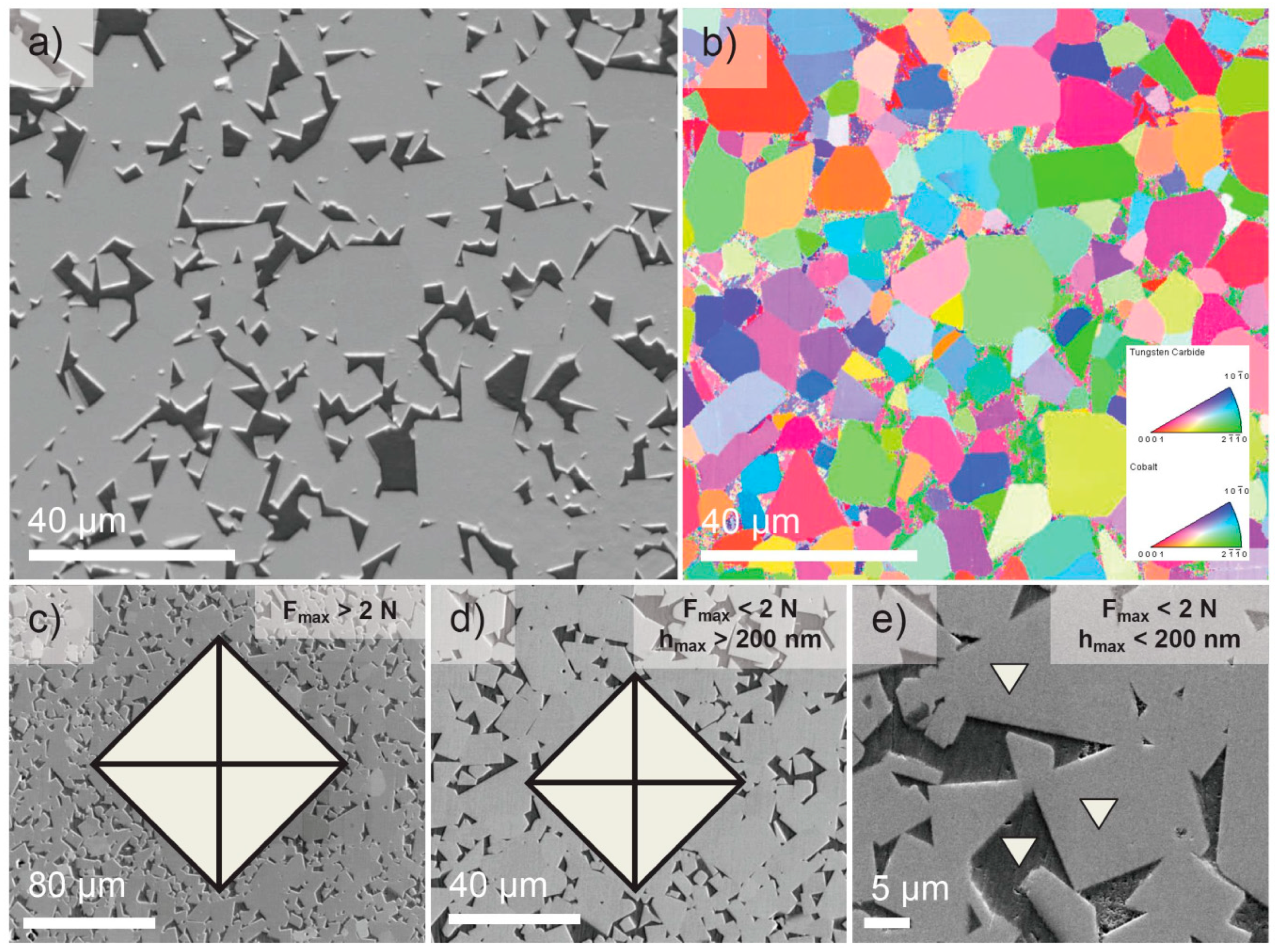
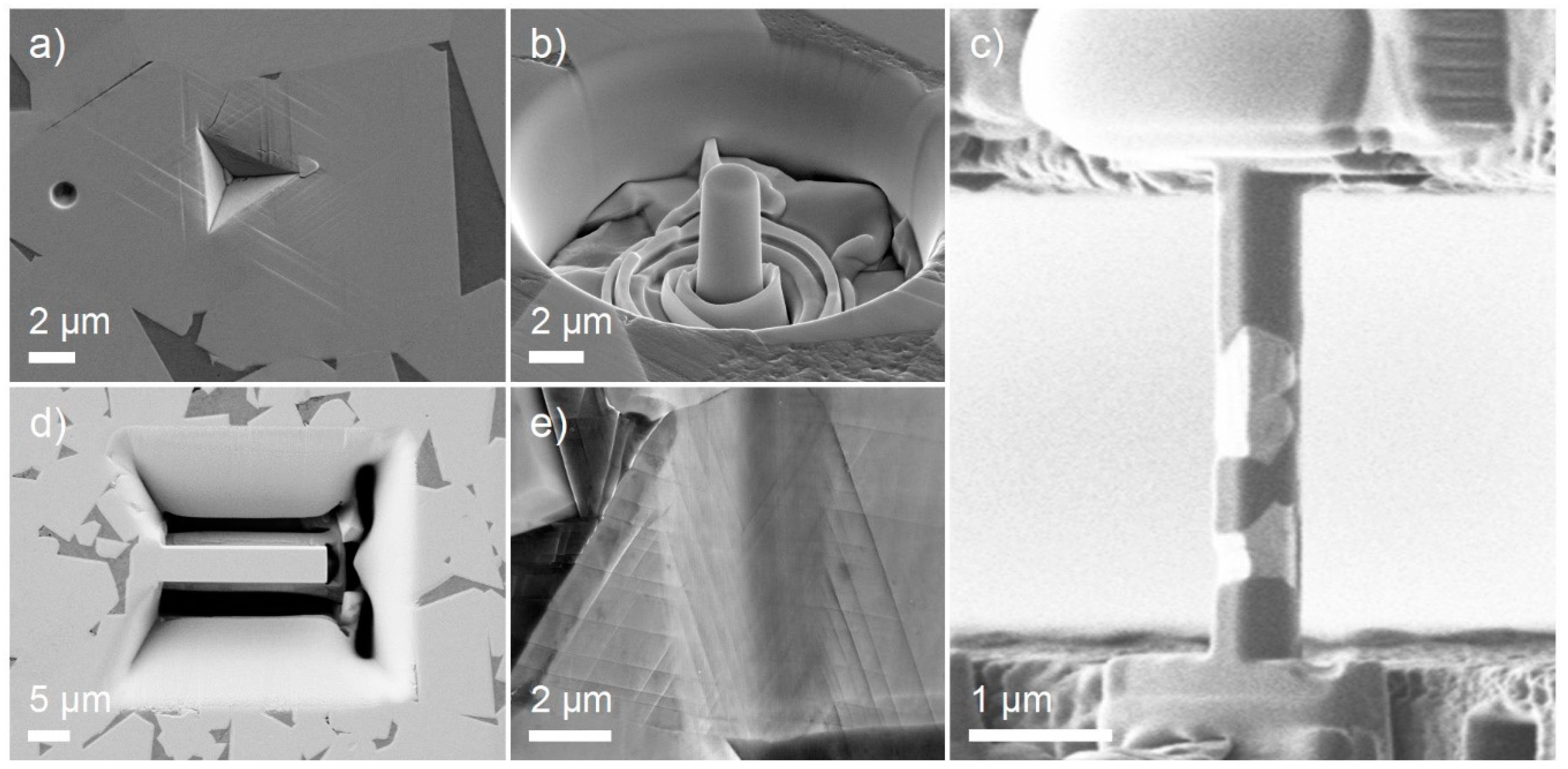
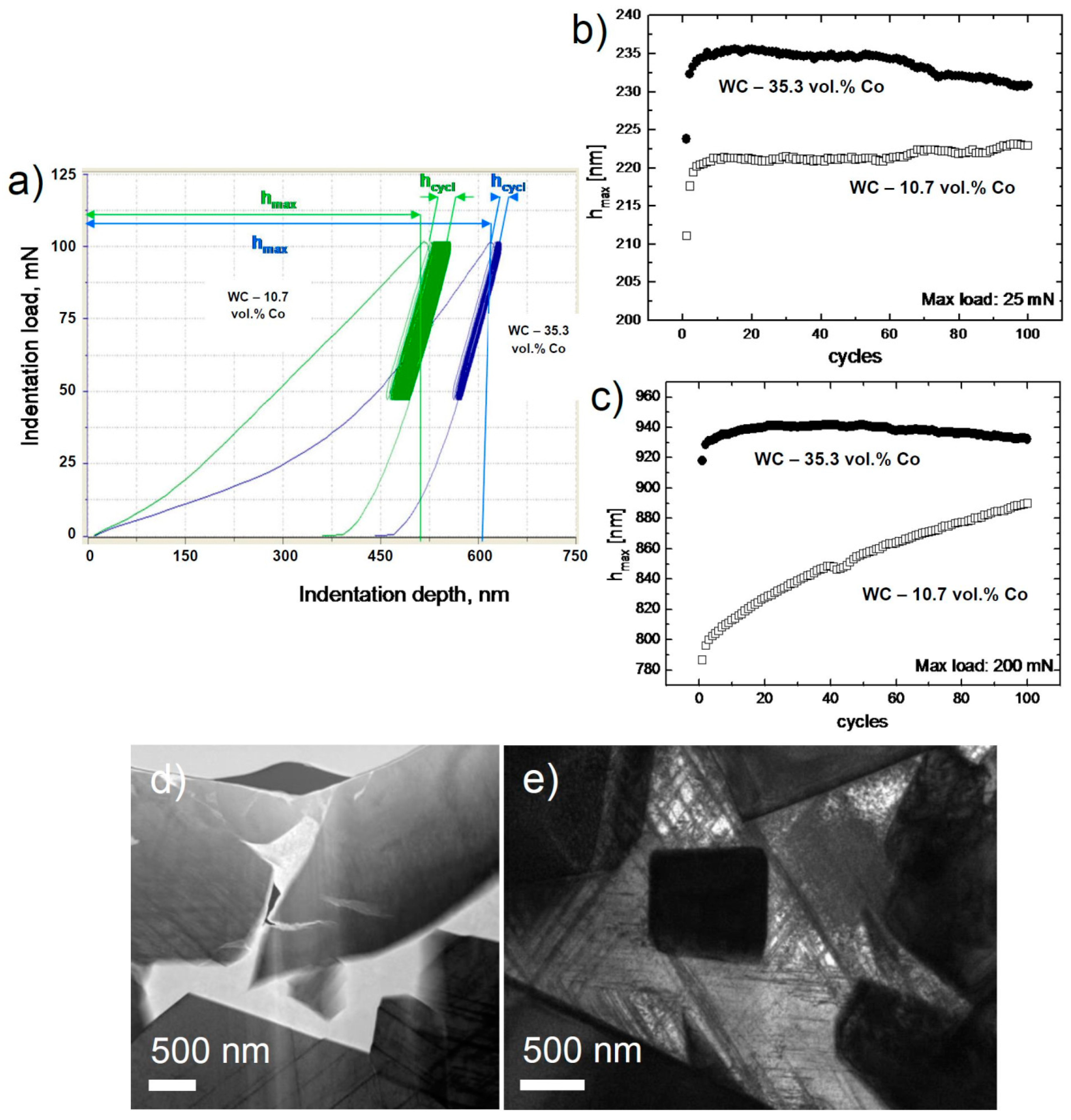
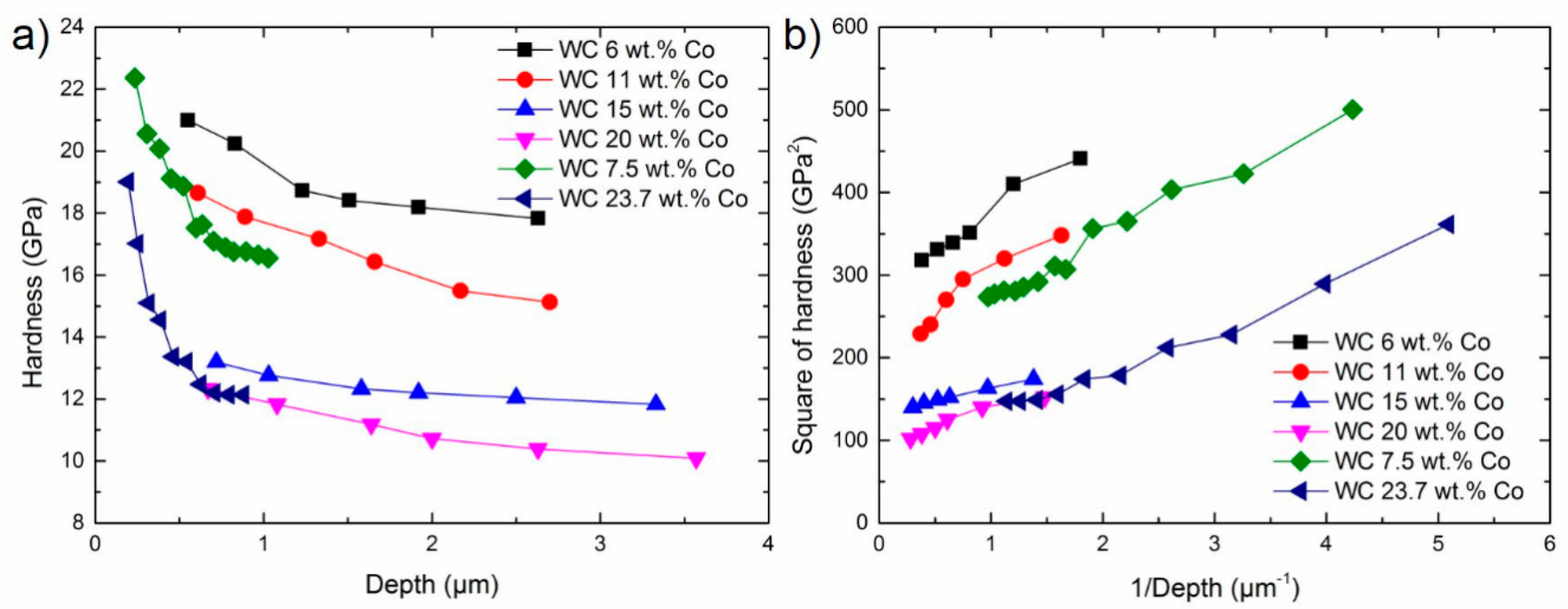
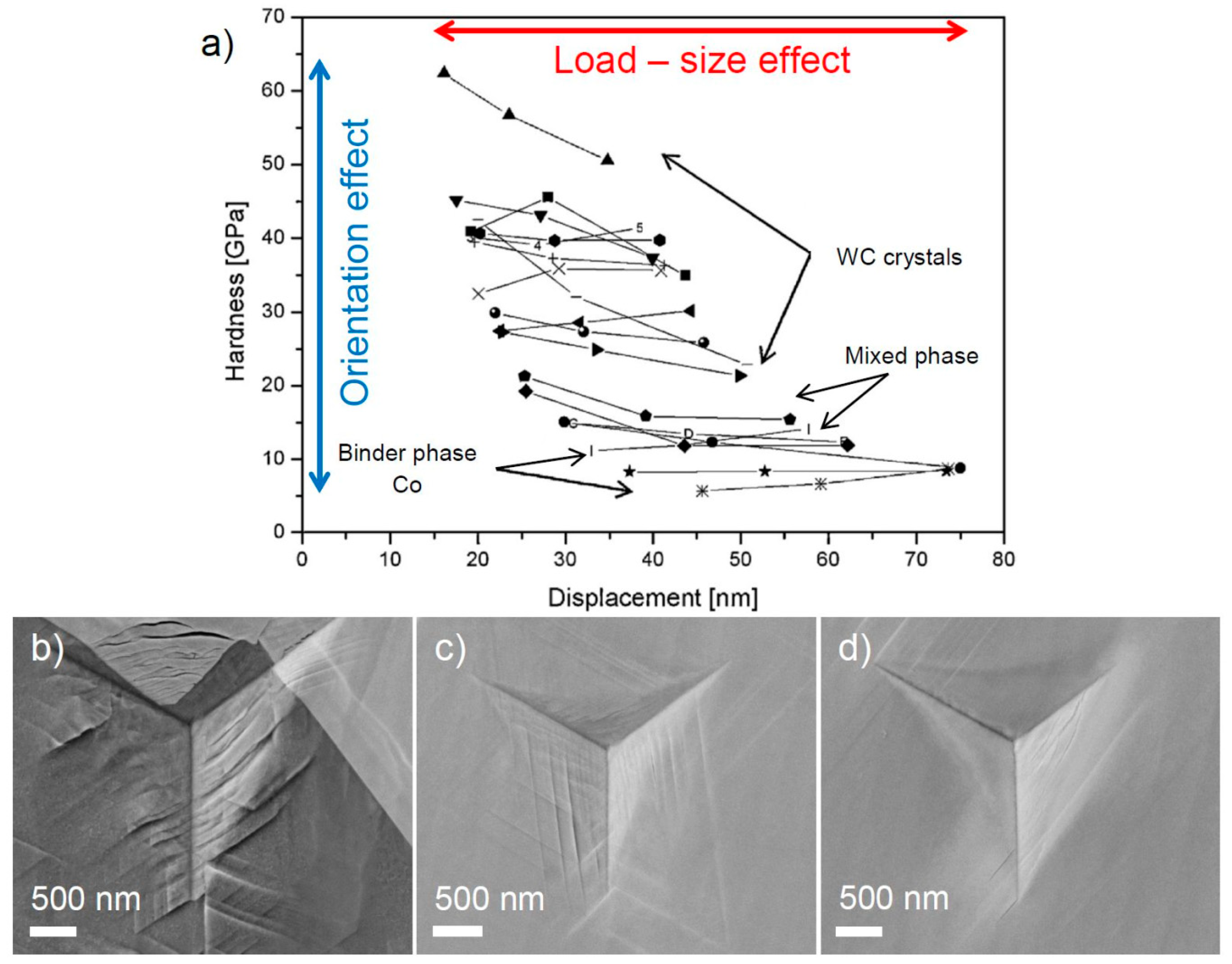
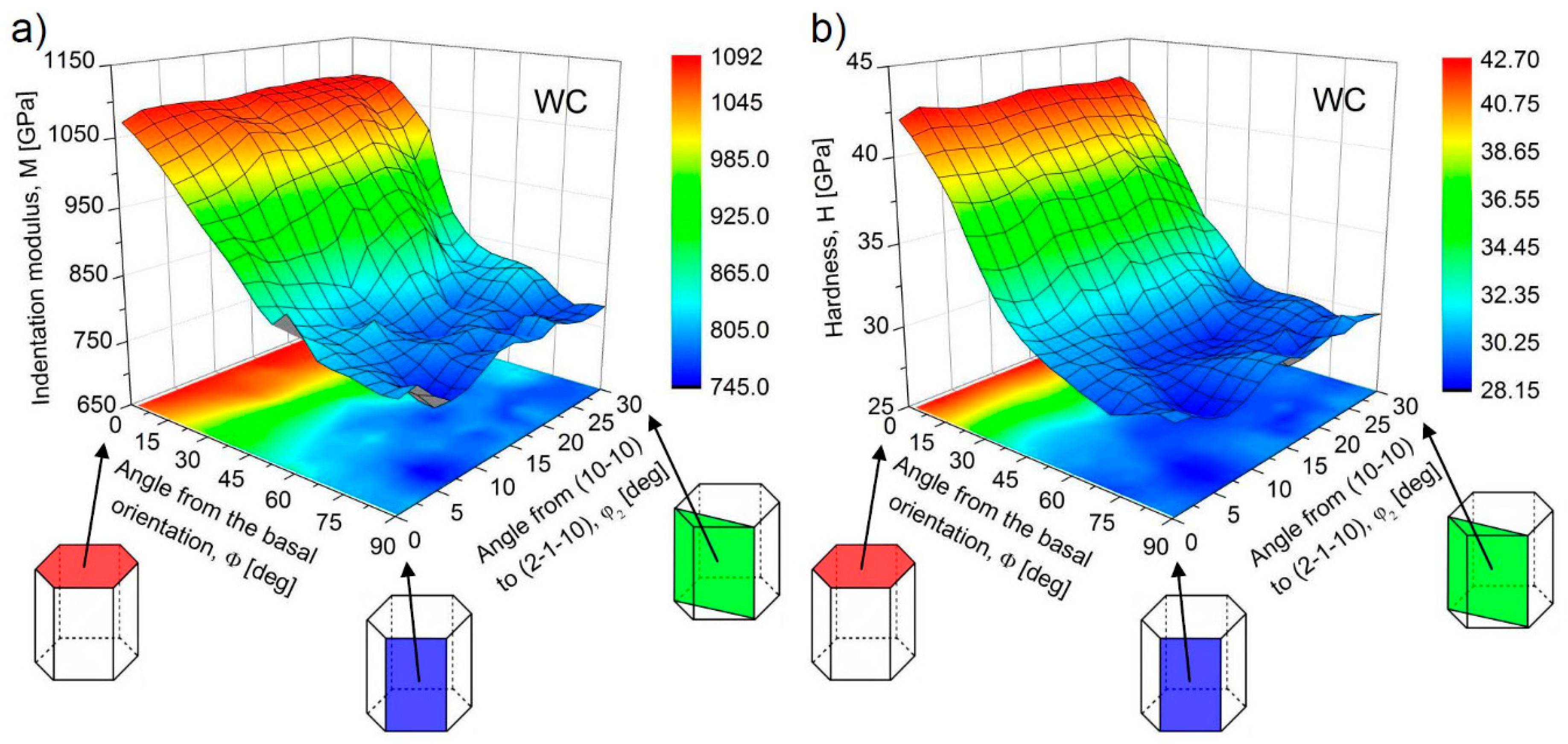
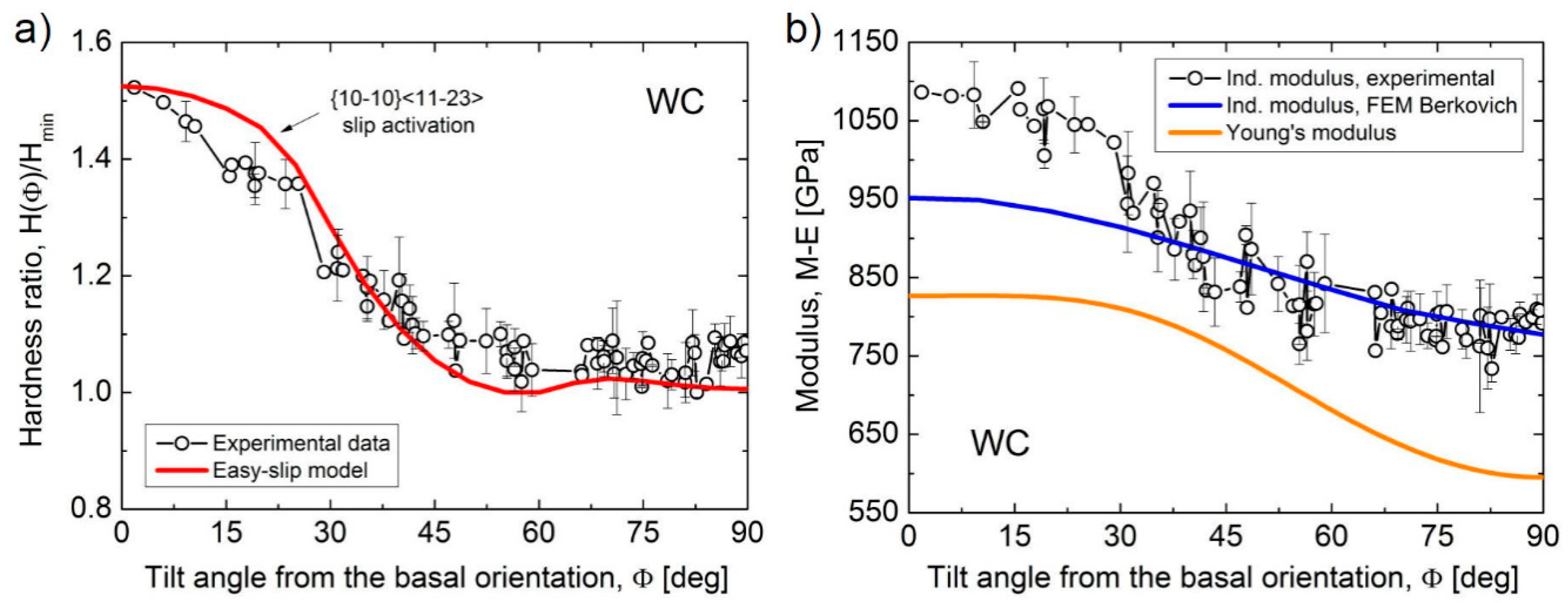

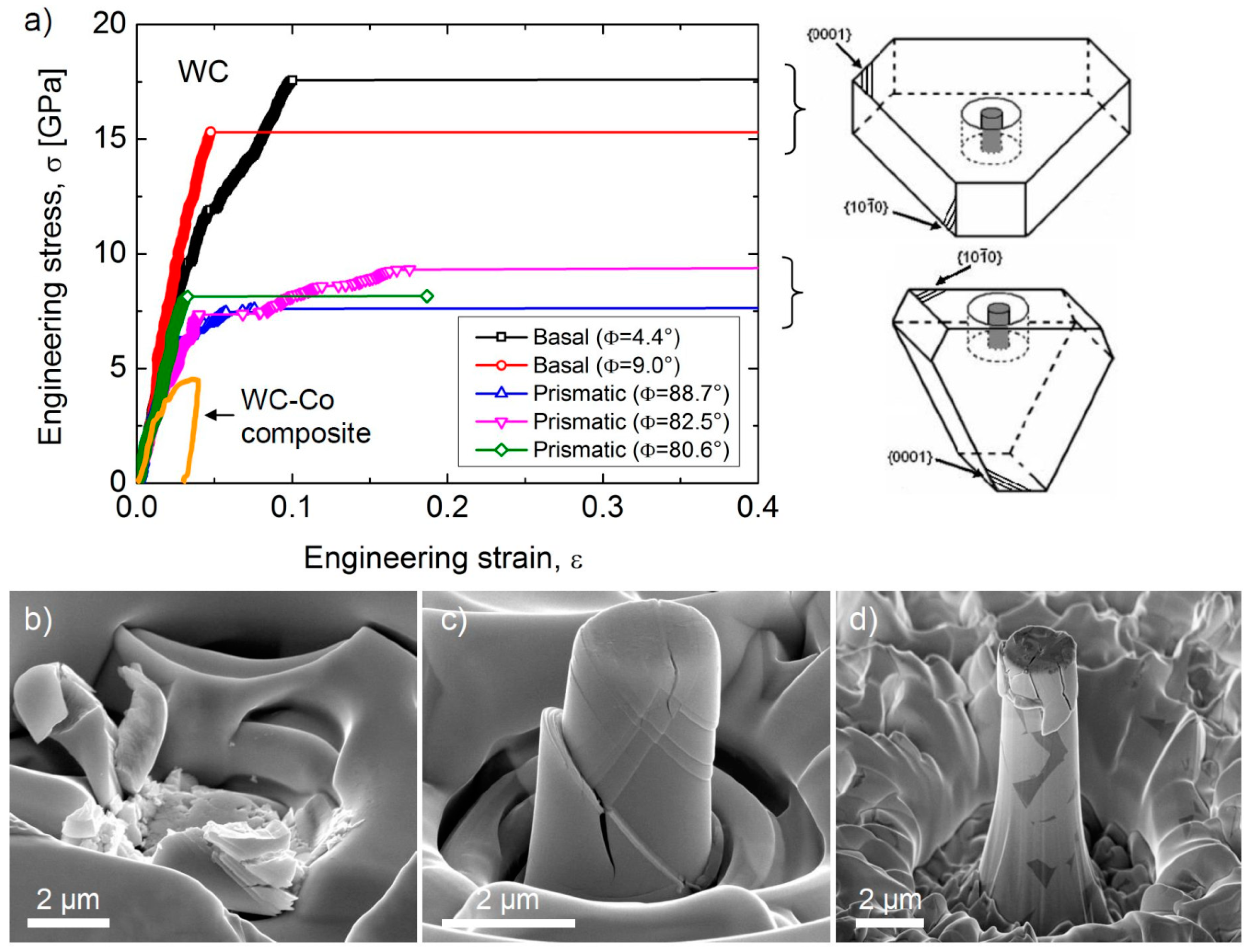
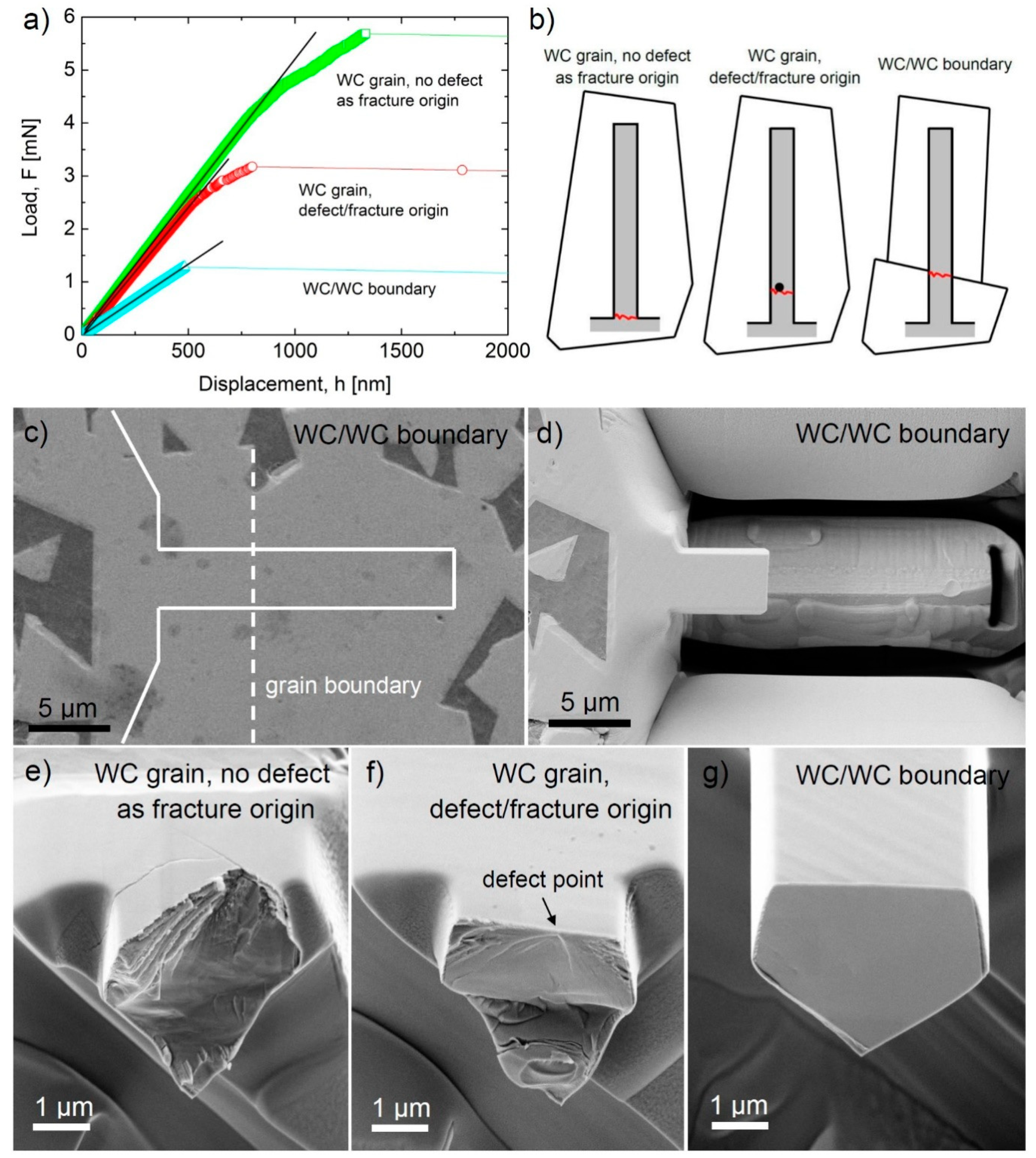
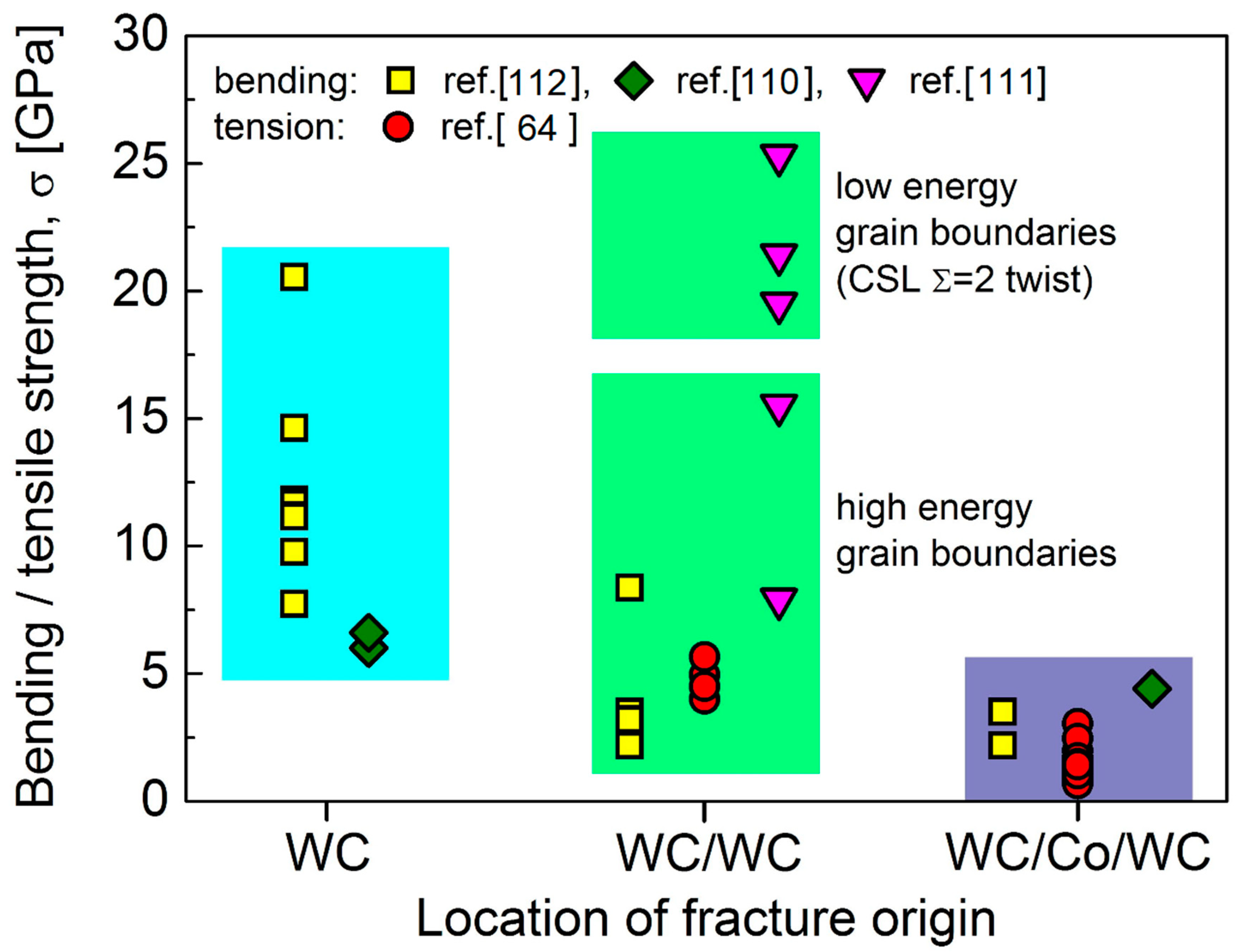
| Author (date), (Ref.) | Form of WC | Type of Indentation | Load Range | Basal Hardness H (GPa) | Prismatic Hardness H (GPa) |
|---|---|---|---|---|---|
| Takahashi and Freise (1965) [72] | single crystal | Vickers macrohardness | 10 N | H = 22.2 ± 0.4 | H = 11.4 ± 0.5 |
| French and Thomas (1965) [73] | single crystal | Knoop microhardness | 1 N | H = 22–24.6 | H = 9.8–23.5 |
| Pons (1968) [74] | single crystal | Vickers microhardness | 1 N 200 mN | H = 20.6 ± 1.1 H = 26.5 ± 1.1 | H = 14.4 ± 1.1 H = 15.3 ± 1.1 |
| Lee (1983) [75] | single crystal | Knoop macrohardness | 10 N | H = 19 | H = 8–18 |
| Bonache et al. (2010) [76] | WC grains | Berkovich nanohardness | 0.3–0.9 mN | H = 25–30 | H = 40–55 |
| Cuadrado et al. (2011) [77] | WC grains | Berkovich nanohardness | 250 mN | H = 25.6 ± 0.2 | H = 17.2 ± 0.1 |
| Roebuck et al. (2012) [78] | WC grains | Vickers microhardness | 200 mN | H = 23.3 H = 32.6 (AFM) | H = 14.1 H = 21.4 (AFM) |
| Duszová et al. (2013) [71] | WC grains | Berkovich nanohardness | 10 mN | H = 40.4 ± 1.6 | H = 32.8 ± 2.0 |
| Csanádi et al. (2015) [79] | WC grains | Berkovich nanohardness | 20–25 mN | H = 43.0 ± 0.8 | H = 28.0 ± 1.0 |
| Roa et al. (2015) [80] | WC grains | Berkovich nanohardness | 15–20 mN | H = 29.9 ± 4.7 | H = 22.0 ± 9.6 |
| Roa et al. (2018) [81] | WC grains | Berkovich nanohardness | 4 mN | H = 32.5 ± 3.5 | H = 25.5 ± 5.0 |
© 2019 by the authors. Licensee MDPI, Basel, Switzerland. This article is an open access article distributed under the terms and conditions of the Creative Commons Attribution (CC BY) license (http://creativecommons.org/licenses/by/4.0/).
Share and Cite
Naughton-Duszová, A.; Csanádi, T.; Sedlák, R.; Hvizdoš, P.; Dusza, J. Small-Scale Mechanical Testing of Cemented Carbides from the Micro- to the Nano-Level: A Review. Metals 2019, 9, 502. https://doi.org/10.3390/met9050502
Naughton-Duszová A, Csanádi T, Sedlák R, Hvizdoš P, Dusza J. Small-Scale Mechanical Testing of Cemented Carbides from the Micro- to the Nano-Level: A Review. Metals. 2019; 9(5):502. https://doi.org/10.3390/met9050502
Chicago/Turabian StyleNaughton-Duszová, Annamária, Tamás Csanádi, Richard Sedlák, Pavol Hvizdoš, and Ján Dusza. 2019. "Small-Scale Mechanical Testing of Cemented Carbides from the Micro- to the Nano-Level: A Review" Metals 9, no. 5: 502. https://doi.org/10.3390/met9050502
APA StyleNaughton-Duszová, A., Csanádi, T., Sedlák, R., Hvizdoš, P., & Dusza, J. (2019). Small-Scale Mechanical Testing of Cemented Carbides from the Micro- to the Nano-Level: A Review. Metals, 9(5), 502. https://doi.org/10.3390/met9050502






